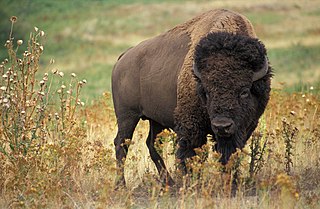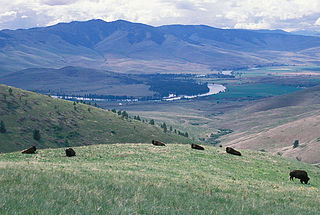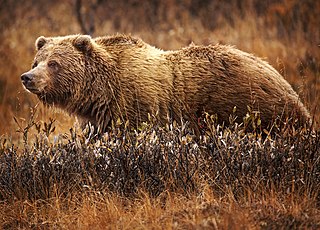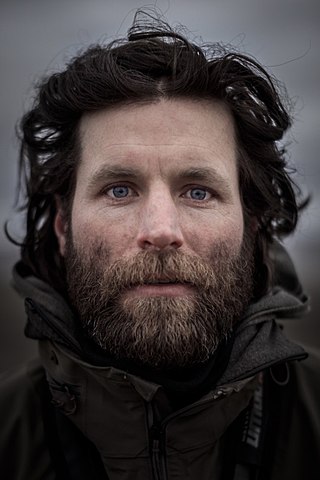Related Research Articles

A bison is a large bovine in the genus Bison within the tribe Bovini. Two extant and numerous extinct species are recognised.

Yellowstone National Park is a national park located in the western United States, largely in the northwest corner of Wyoming and extending into Montana and Idaho. It was established by the 42nd U.S. Congress with the Yellowstone National Park Protection Act and signed into law by President Ulysses S. Grant on March 1, 1872. Yellowstone was the first national park in the U.S. and is also widely held to be the first national park in the world. The park is known for its wildlife and its many geothermal features, especially the Old Faithful geyser, one of its most popular. While it represents many types of biomes, the subalpine forest is the most abundant. It is part of the South Central Rockies forests ecoregion.

The American bison, commonly known as the American buffalo, or simply buffalo, is a species of bison that is endemic to North America. It is one of two extant species of bison, along with the European bison. Its historical range circa 9000 BC is referred to as the great bison belt, a tract of rich grassland spanning from Alaska south to the Gulf of Mexico, and east to the Atlantic Seaboard, as far north as New York, south to Georgia, and according to some sources, further south to northern Florida, with sightings in North Carolina near Buffalo Ford on the Catawba River as late as 1750.

The Greater Yellowstone Ecosystem (GYE) is one of the last remaining large, nearly intact ecosystems in the northern temperate zone of the Earth. It is located within the northern Rocky Mountains, in areas of northwestern Wyoming, southwestern Montana, and eastern Idaho, and is about 22 million acres (89,000 km2). Yellowstone National Park and the Yellowstone Caldera 'hotspot' are within it.

The Lamar River is a tributary of the Yellowstone River, approximately 40 miles (64 km) long, in northwestern Wyoming in the United States. The river is located entirely within Yellowstone National Park.

Doug Peacock is an American author, filmmaker, wildlife activist, and Vietnam War veteran. He is best known for his work dedicated to grizzly bear recovery in the lower-48, his book Grizzly Years: In Search of the American Wilderness and serving as the model for the well-known character George Washington Hayduke in Edward Abbey's novel The Monkey Wrench Gang. Doug is the co-founder of several conservation organizations including Round River Conservation Studies and Save The Yellowstone Grizzly.
Maryanne Vollers is an American author, journalist and ghostwriter. Her first book, Ghosts of Mississippi, was a finalist in non-fiction for the 1995 National Book Award. Her many collaborations include the memoirs of Hillary Rodham Clinton, Dr. Jerri Nielsen, Sissy Spacek, Ashley Judd, and Billie Jean King. Her second book on domestic terrorism, Lone Wolf: Eric Rudolph – Murder, Myth, and the Pursuit of an American Outlaw, was published in 2006. A former editor at Rolling Stone she has written articles for publications such as Esquire, GQ, Sports Illustrated, Time,and The New York Times Magazine.

The history of wolves in Yellowstone includes the extirpation, absence and reintroduction of wild populations of the gray wolf to Yellowstone National Park and the Greater Yellowstone Ecosystem. When the park was created in 1872, wolf populations were already in decline in Montana, Wyoming and Idaho. The creation of the national park did not provide protection for wolves or other predators, and government predator control programs in the first decades of the 1900s essentially helped eliminate the gray wolf from Yellowstone. The last wolves were killed in Yellowstone in 1926. After that, sporadic reports of wolves still occurred, but scientists confirmed in the mid-1900s that sustainable gray wolf populations had been extirpated and were absent from Yellowstone as well as 48 states.

The ecology of the Rocky Mountains is diverse due to the effects of a variety of environmental factors. The Rocky Mountains are the major mountain range in western North America, running from the far north of British Columbia in Canada to New Mexico in the southwestern United States, climbing from the Great Plains at or below 1,800 feet (550 m) to peaks of over 14,000 feet (4,300 m). Temperature and rainfall varies greatly also and thus the Rockies are home to a mixture of habitats including the alpine, subalpine and boreal habitats of the Northern Rocky Mountains in British Columbia and Alberta, the coniferous forests of Montana and Idaho, the wetlands and prairie where the Rockies meet the plains, a different mix of conifers on the Yellowstone Plateau in Wyoming, the montane forests of Utah, and in the high Rockies of Colorado and New Mexico, and finally the alpine tundra of the highest elevations.

The South Central Rockies forests is a temperate coniferous forest ecoregion of the United States located mainly in Wyoming, Idaho, and Montana. It has a considerably drier climate than the North Central Rockies forest.

The Montana valley and foothill grasslands are an ecoregion of northwestern North America in the northern United States and southern Canada.

American Prairie is a prairie-based nature reserve in Central Montana, United States, on a shortgrass prairie ecosystem with migration corridors and native wildlife. This wildlife conservation area is being developed as a private project of the American Prairie Foundation (APF), a non-profit organization. The reserve covers 462,803 acres (187,290 ha). The organization hopes to expand it greatly through a combination of both private and public lands.

The grizzly bear, also known as the North American brown bear or simply grizzly, is a population or subspecies of the brown bear inhabiting North America.
Paul Schullery was born in Middletown, Pennsylvania in 1948. He now lives in Bozeman, Montana. He has always been an avid hiker, fly fisher, photographer, wildlife watcher and has continuously documented his experience in his writing. Today, he is the author, co-author or editor of more than 40 books and numerous articles. His main focus for his works has to do with nature and our relationship with it as well as the wonders it presents us with now. Schullery studied American History at Wittenberg University and Ohio University, receiving his M.A. and B.A., respectively.
Chris Morgan is a British-born ecologist, conservationist, TV host, filmmaker, podcaster, and author. His ecology and conservation work focuses on bears and other large carnivores worldwide. Over the last 25 years Morgan has worked as a wildlife researcher, wilderness guide, and environmental educator on every continent where bears exist.

Douglas H. Chadwick is an American wildlife biologist, author, photographer and frequent National Geographic contributor. He is the author of fourteen books and more than 200 articles on wildlife and wild places.

Casey Anderson is an American filmmaker, wildlife naturalist, and television presenter known for translating human relationships with the natural world and wild animals to various audiences. He has been a host and executive producer of the Nat Geo WILD channel television series, Expedition Wild and America the Wild with Casey Anderson, and for raising Brutus the Bear, a grizzly bear that he rescued and adopted as a newborn cub. Brutus and Anderson have appeared in many films, documentaries, television commercials, and live educational shows across the United States.
Thomas D. Mangelsen is an American nature and wildlife photographer and conservationist. He is most famous for his photography of wildlife in the Greater Yellowstone Ecosystem, as he has lived inside the zone in Jackson, Wyoming, for over 40 years. In 2015, he and nature author Todd Wilkinson created a book, The Grizzlies of Pilgrim Creek, featuring a grizzly bear known as Grizzly 399, named so due to her research number. He has been active in the movement to keep the Yellowstone area grizzly bears on the Endangered Species List. Mangelsen is also known for trekking to all seven continents to photograph a diverse assortment of nature and wildlife. A photograph he took in 1988, Catch of the Day, has been labeled "the most famous wildlife photograph in the world". In May 2018, he was profiled on CBS's 60 Minutes. He has received dozens of accolades throughout the decades.

Ronan Donovan is a conservation photographer, filmmaker, wildlife biologist, and National Geographic Explorer and Storytelling Fellow.
References
- 1 2 3 4 5 Doug Peacock, Andrea Peacock (2009). In the Presence of Grizzlies: The Ancient Bond Between Men and Bears. Globe Pequot. pp. 47–50. ISBN 978-1-59921-490-0.
- ↑ "National Parks To Start Charging Photographers "Location Fees"". National Press Photographers Association . Retrieved September 21, 2011.
- ↑ "INTERIOR IMPOSES NEW FEES FOR PHOTOGRAPHY ON PUBLIC LAND". Society of Environmental Journalists . Retrieved September 21, 2011.
- ↑ "Wolves in Paradise awards". ITVS . Retrieved September 19, 2011.
- 1 2 "Awards and Honors". Montana State University . Retrieved September 19, 2011.